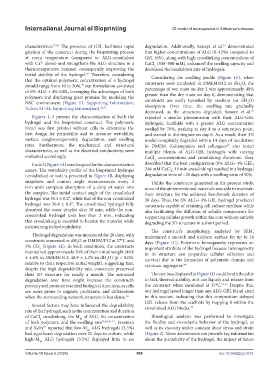Page 517 - IJB-10-5
P. 517
International Journal of Bioprinting 3D model of neurogenesis in Alzheimer’s disease
characteristics. 47,48 The presence of GEL facilitates rapid degradation. Additionally, Sonaye et al. demonstrated
53
gelation of the construct during the bioprinting process that higher concentrations of ALG (8–12%) compared to
at room temperature (compared to ALG-crosslinked GEL (6%), along with high crosslinking concentrations of
with Ca alone) and strengthens the ALG structure in a CaCl (300–500 mM), enhanced the swelling capacity and
2+
2
thermoresponsive manner, consequently improving the decreased the breakdown rate of hydrogels.
initial stability of the hydrogel. Therefore, considering Considering the swelling profile (Figure 1F), when
36
that the optimal polymeric concentration of a hydrogel constructs were incubated in DMEM/F12 or dH O, the
should range from 10 to 20%, our formulation consisted percentage of wet mass on day 2 was approximately 40%
49
2
of 6% ALG + 4% GEL, leveraging the advantages of both greater than the dry mass on day 0, demonstrating that
polymers and displaying great promise for modeling the constructs are easily tumefied by medium (or dH O)
NSC environment (Figure S1, Supporting Information; 2
Videos S1–S4, Supporting Information). 28,33 absorption. Over time, the swelling rate gradually
decreased, as the structures degraded. Sonaye et al.
53
Figures 1–3 present the characterization of both the reported a similar phenomenon with their ALG-GEL
hydrogel and the bioprinted construct. The polymeric hydrogels. Scaffolds with a greater ALG concentration
blend was first printed without cells to determine the swelled by 70%, peaking at day 4 to a saturation point,
best design for printability and to measure wettability, and started to disintegrate on day 8. As a result, their 3D
surface roughness/porosity, degradation, and swelling model completely degraded within 14 days of incubation
rates. Furthermore, the mechanical and structural in DMEM. Kaliampakou and colleagues also tested
50
characteristics, as well as the electrical conductivity, were multiple blends of ALG-GEL hydrogels with varying
evaluated accordingly. CaCl concentrations and crosslinking durations. They
2
Code 2 (Figure 1A) was designed for the characterization described that the best configuration (8% ALG+ 4% GEL;
assays. The wettability profile of the bioprinted hydrogel 248 mM CaCl ; 15 min crosslinking) resulted in a hydrogel
2
(crosslinked or not) is presented in Figure 1B, displaying degradation time of ~20 days with a swelling ratio of 50%.
snapshots and contact angle measurements every 2 Unlike the constructs generated in the present study,
min until complete absorption of a drop of water into none of the aforementioned materials was able to maintain
the samples. The initial contact angle of the crosslinked their structure for the achieved benchmark duration of
hydrogel was 55.3 ± 0.2°, while that of the non-crosslinked 28 days. Thus, the 6% ALG+ 4% GEL hydrogel produced
hydrogel was 30.4 ± 0.4°. The crosslinked hydrogel fully constructs capable of retaining cell culture medium while
absorbed the water droplet after 38 min, while the non- also facilitating the diffusion of soluble components for
crosslinked hydrogel took less than 2 min, indicating supporting cellular growth within the core without entirely
that crosslinking is essential to harden the material while degrading the 3D structure in a short period.
maintaining its hydrophilicity.
The construct’s morphology, analyzed by SEM,
Hydrogel degradation was monitored for 28 days, with maintained a smooth and uniform surface for up to 14
constructs immersed in dH O or DMEM/F12 at 37°C and days (Figure 1C). Polymeric homogeneity represents an
2
5% CO (Figure 1E). In both conditions, the constructs important attribute of the hydrogel because heterogeneity
2
maintained approximately 50% of their initial weight (49.6 in its structure can jeopardize cellular adhesion and
± 4.6% in DMEM/F12; 46.9 ± 4.2% in dH O) (p < 0.001 survival due to the formation of polymeric clumps and
2
relative to their respective initial weight), suggesting that, cytotoxic aggregates. 54
despite the high degradability rate, constructs preserved
their 3D structure for nearly a month. The sustained The size loss displayed in Figure 1D could be attributable
degradation over time might increase the construct’s to GEL thermal stability, as it can liquefy and release from
porosity and promote essential biological functions, as cells the construct when incubated at 37°C. 52,55 Despite this,
are more prone to migrate, proliferate, and differentiate our hydrogel lasted longer than any ALG-GEL blend cited
when the surrounding network structure is less dense. 50 in this section, indicating that this composition delayed
GEL release from the scaffolds by trapping it within the
Several factors may have influenced the degradability 55
rate of the hydrogel, such as the concentration and duration crosslinked ALG blocks.
of CaCl crosslinking, the M of ALG, the concentration Rheological analysis was performed to investigate
2
W
of both polymers, and the swelling rate 35,45,50–53 . Freeman the fluidity and viscoelastic behavior of the hydrogel, as
and Kelly reported that low-M ALG hydrogels (3.5%) well as its viscosity under constant shear stress and strain
51
W
had significant degradation over 21 days in culture, while (Figure 2). These assessments can provide key information
high-M ALG hydrogels (3.5%) displayed little to no about the printability of the hydrogel, the impact of forces
W
Volume 10 Issue 5 (2024) 509 doi: 10.36922/ijb.3751

